Brush Embroidery Royal Icing Accents with Oh, Sugar Events {Guest Post}
I have a long, ever-growing list of favorite cookie decorators and Anglea, of Oh, Sugar Events is definitely at the top. I am constantly amazed and inspired by her gorgeous party spreads and intricately detailed cookie designs. I’ve also had the honor of meeting Angela in real life and she’s the perfect combination of humor and humility.
Today Angela is sharing her simple but brilliant idea for brush embroidery royal icing accents.
Ahhh. Beautiful brushed embroidery. I love love love the look, especially when used monochromatically as it adds a lot of depth and texture to flowers. Here’s a handy dandy tutorial breaking down the steps of these layered royal icing transfers. They make for really pretty decorative touches to add to your cookies and cakes, and are actually pretty fun to do once the kids are in bed and you’ve settled in for a night in front of the tube. Enjoy!
The first thing I did was find a pleasing piece of floral clip art by Googling “camellia clipart.” Resize it to about 2.5 inches high and then copy and paste it enough times to fill an 8.5 x 11 sheet of paper. Print that bad boy out and boom! You’ve got yourself a template. Here are the rest of your tools of the trade:
A. Wax paper
B. Bowl of water
C. THIN offset spatula
D. Piping bag fitted with #2 tip with firm/flood royal icing
E. Yellow nonpareils
F. Flower clip art template
G. Paper towel
H. Small pointed tipped paintbrush
Working on a large flat workspace, place a large piece of waxed paper over your clip art template. (TIP: Make sure both template and wax paper are as flat as possible so your transfers won’t crack or be difficult to remove due to curved paper.)
STEP 1: Fill a piping bag fitted with a number 2 tip with what I call “the perfect in between” icing (a consistency firm enough to hold a piped lined AND loose enough to flood) and outline the outermost petals. Work left to right piping three flowers at a time. Start from the top of the template and work your way down so your hand doesn’t accidentally smear your work.
STEPS 2 & 3: Generously fill in the first three flower outlines.
STEP 4: Repeat until entire sheet is filled and continue on until you have made as many as desired. (TIP: Make 6-10 more than you will need just in case you have any breakage.)
Use the same steps on the smaller center petal details to create the top layer of your camellias.
You can use your heat gun if you have one to accelerate the drying time to get on to the fun part – the brushwork! When the filled flower shapes are dry-ish to the touch you can move on to the next steps:
STEP 1: Using the same icing you did to pipe and fill the flower shapes, pipe the outline of one petal.
STEP 2: Wet your paintbrush in your bowl of water.
STEP 3: Dab off excess water on your paper towel so it is just moist.
STEP 4: Drag your paintbrush through the wet outline from the top to the center of the flower. (TIP: Icing will accumulate on the tip of your brush, so wipe off excess icing on your paper towel. Try to avoid dipping paintbrush in water as much as possible because if your brush is too wet you will lose definition in the strokes.)
STEP 5: This is what your petal should look like after a first passthrough of your paintbrush.
STEP 6: Run your brush through again working the icing to get the look you like. (TIP: I like to work the left and right outside edges a little less to maintain more definition between each petal.
PIC 1: Too much water in my brush leads to mushy strokes.
PIC 2: Too little water in my brush and the strokes get broken up and a little scraggly.
PIC 3: Good balance of water in my brush for fluid strokes that hold their shape.
Continue on working petal by petal. I like to work four flowers at a time, piping a petal on four different flowers, then quickly going back to do my brushwork before they can set up and start to crust over. Do this petal work creating five petals per flower. Once you get the hang of it, it goes fairly quickly.
The final product of the larger flower.
REMOVING TRANSFERS FROM WAX PAPER
STEP 1: WAIT! No seriously. Wait 24 hours before trying to remove from the wax paper. I’ve tried cheating and doing it too soon and they are just not dry enough to handle. They WILL crack. They WILL smoosh. They WILL NOT cleanly come off of the paper or your spatula. But go ahead. I know you’ll need to try at least one before it’s time (you’re not alone, I do it every single time, thinking THIS time will be different!).
STEP 2: Don’t wait TOO long to take them off the wax paper. I left some transfers for about a week and they were practically permanently fused. I broke a ton of them and really struggled to get the ones that survived off.
STEP 3: Take your thinnest offset spatula an slowly wiggle it under an edge. keep the flat back side of your spatula firmly pressed to your work surface to avoid cracking your transfers. Once you get it started continued to slide it all the way across. Aaaand hooray! You did it!
If they don’t seem thoroughly dry, flip them over and give them some more dry time.
Repeat the same brush embroidery steps on the smaller flower. On these I work two petals at a time on each flower, which makes these go even faster. When they are dry, remove with the same technique as you did with the larger flower.
Finished inner flower.
FINISHING TOUCHES
STEP 1: Pipe a small blob of the same color icing in the center of the smaller flower.
STEP 2 & 3: Add nonpareils to icing blob while still wet. (TIP: after doing a few of these I wised up and stopped hand sprinkling and just turned the small flower with wet icing blob face down directly into the container of nonpareils. Way less messy and much better coverage. Live and learn.)
STEP 4: Pipe a blob of the same colored icing in the center of the larger flower.
STEP 5: Center smaller flower over larger flower.
STEP 6: Press gently together to secure the two pieces together.
Final product.
These can be used simply to decorate cookies.
Or use just the smaller flower centers and go hog wild.
They are also pretty fab as cake accents.
I hope you’ll give these a try. Make them ahead of time when you have a lazy evening and the next time you need to dress up a dessert you’ll have these beauties ready to go!
Thanks again Angela for sharing your decorating wisdom and humor. Everyone should definitely take the time to make a few of these beauties. You never know when they might save the day. Seriously. You can read all Angela’s baking mishap and recovery HERE.
In addition to being awesome, Angela also hosts “Cookie Boot Camps” which YOU can attend. I highly recommend stalking her blog and Facebook page {but not her house because that would be weird} to keep up to date with upcoming classes and projects.
Happy Wednesday everyone!










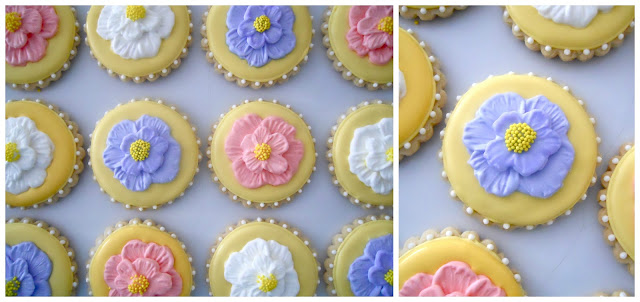



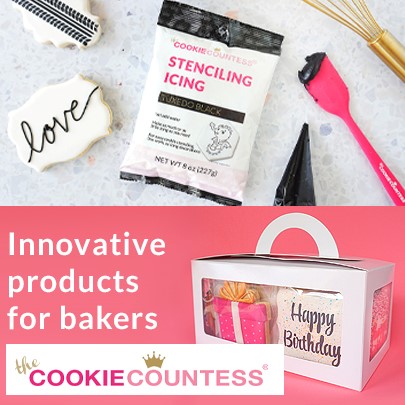
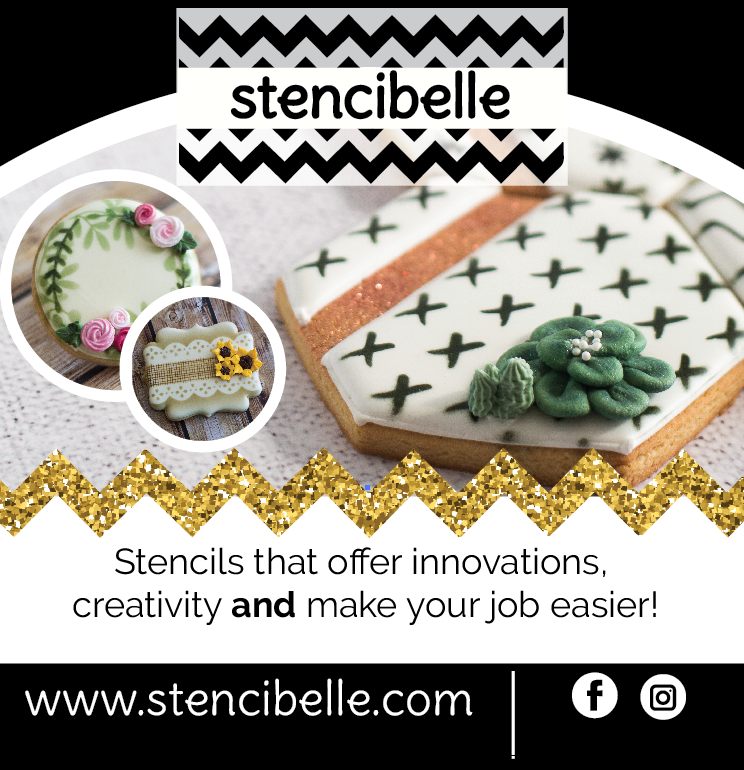




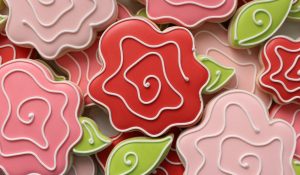
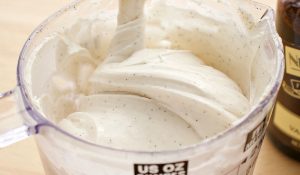
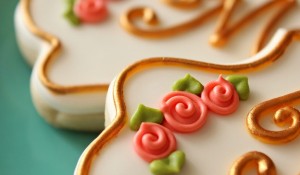
So damn pretty!
these are great..so easy (looking!) but what a great way to use up icing as I have enough eyes to last a few Halloweens. Thanks for that photo of the flower too….great idea!
Fabulous post! I love all the ways you used them, but that cake is just stunning!! Such a cute and unique way to glam up any cake!
Great post Angela! I really admire your creativity and style!
Thanks for sharing her with us Callye!
when I saw Oh Sugars! brilliant cake I really wondered how she did these flowers….and here we go!
Thank you Sugarbelle for inviting Oh! Sugar over to play……..she is one of my fav’s for sure!
I adore Royal Icing Transfers and you have taken it to the next level with by adding layers! LOVE it!! Thanks so much for sharing and that black and white Chanel cake…STUNNING!!!!
These are so awesome! I wouldn’t expect anything less from her though… she blows my mind every time she posts something!!! 🙂
Just beautiful!! I would have never thought of doing them in two separate RI transfers!! You are brilliant.
Oh Sugar is an amazing artist! Everything she does is gorgeous! This is a great tutorial and I can’t wait to use it.
DUDE! These are awesome, and I bow down to you, as RI transfers & I have not been great friends in the past. Just WOW! The effect when covering a whole cake = SPEECHLESS! Love, love, love!
Great tutorial just in time for Spring cookie decorating!
Wow o’ wow, two of my favorite people together playing together.
This is such a beautiful tutorial, love those flowers.
Thank you Sugarbelle and Oh sugar, xoxo
Great tutorial… I really struggle with brush embroidery and you made this seem doable! The flowers are beautiful I love Angela, she is an amazing cookier and such a sweet person. I went to her Cookie Bootcamp in February and it was GREAT! thanks for sharing…
Thank you for sharing. I love this technique!. I’m off to make icing and give it a try. You are both amazing ladies and appreciated!
I love the look of brush embroidery and after reading your tutorial, I think it’s time I try it out. Thanks for the great post – and thank you Callye for having her as your guest!
Ooooh, I love the black & white flowers, stunning! Thank you for sharing!
You are so great! I thank you for the emotions that you give me! You make my day!!!
Angela is so clever and talented! That black and white cake is so stunning! Thank you both for sharing this great tutorial! 🙂
I’ve tryin to learn how to do this design on cookies & kept messing up. Now that i c this tutuorial I’m going to it. Thanks
Looks like I need to get my brush out again! Beautiful!
Oh they do make fabulous cake accents. Love them., lovely 🙂 Thanks for sharing, Anglea and Callye thanks for sharing Anglea.
I have set a goal for myself to make some of these before summer. So pretty! Thanks for the detailed tutorial! I am glad you included a firm warning to wait 24 hours for them to dry…I will have to tie my hands behind my back:)
Thanks for sharing your talents Angela (and Callye)!
Thank you so much for this detailed tutorial! I tried these and they turned out so nicely!! Love this technique and can’t wait to try it again! Here’s a link to the cookies I made: http://www.bakedbyrachel.blogspot.com/2013/04/flower-cookies-for-flower-artist.html
You make it look so easy……beautiful idea.
QUESTION – Would using parchment paper make it easier to get them off?
PS…I wish you had that feature here where you could sign up to be notified when
you or another answers posted questions…….just hoping.
I am totally addicted to your blogs and tutorital
So sweet :)) I love it. Thanks for your sharing.
I love it! Thank you for sharing your craft and talent with us, I’m constantly learning from your blog and tutorials and I appreciate you more than words can ever express.